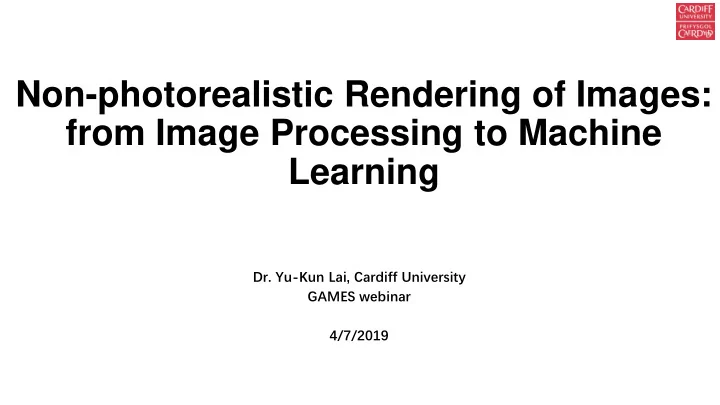

Non-photorealistic Rendering of Images: from Image Processing to Machine Learning Dr. Yu-Kun Lai, Cardiff University GAMES webinar 4/7/2019
Non-Photorealistic Rendering A well researched topic that mimics artistic styles using computer algorithms Photo Cartoon Painting Pen & Ink
Non-Photorealistic Rendering: Applications Technical illustrations Scientific visualisation
Our Work: Traditional Methods Dedicated algorithms are developed to create specific styles. Rosin & Lai, Computational Aesthetics, 2013. Rosin & Lai, Graphical Models, 2013. Rosin & Lai, Computational Aesthetics, 2015. Lai & Rosin, IEEE Trans. Image Processing, 2014.
Artistic Minimal Rendering Key observations: Using a small number of tones Simple primitives: lines and tonal blocks Portrait by Andy Warhol Input Single-scale Multi-scale Artistical minimal rendering with lines and blocks, Graphical Models, 2013.
Artistic Minimal Rendering: Pipeline
Artistic Minimal Rendering: 3-tone lines Input Lines only (2-tone) 3-tone posterised into 3 levels
Artistic Minimal Rendering: Tonal Blocks
Artistic Minimal Rendering: Tone Overlay
Results and Extensions
Results and Extensions
GAN-based Image Synthesis Pix2Pix CycleGAN
CartoonGAN We address cartoon stylisation of images Using unpaired content and style image sets Training data easy to obtain Content: normal photos from Flickr Style: key frames from cartoon films CartoonGAN: Generative Adversarial Networks for Photo Cartoonization. CVPR, 2018.
CartoonGAN: architecture Network architecture Generator: similar to [Johnson et al. 2016] Discriminator: differentiate real and synthesised images
CartoonGAN: content loss Content loss: Use L1 instead of L2 to cope with local large differences (recover flat shading)
CartoonGAN: adversarial loss Adversarial loss Edges are often lost since they only cover a small number of pixels We add an edge promoting term in adversarial loss by penalising cartoon images with edges smoothed
CartoonGAN: initialisation Initialisation Traditional random initialisation does not give good results To avoid the GAN model stuck at poor local minima, we start generator learning that only aims to reconstruct the content of the input images.
CartoonGAN: Results
CartoonGAN: Results
APDrawingGAN Portrait drawings: a longstanding and distinct art form, which typically use a sparse set of continuous graphical elements (e.g., lines) to capture the distinctive appearance of a person APDrawingGAN: Generating Artistic Portrait Drawings from Face Photos with Hierarchical GANs. CVPR, 2019 (oral).
APDrawingGAN : Challenges Artistic portrait drawings (APDrawings) are substantially different from painting styles studied in previous work: Highly abstract, sparse but continuous graphical elements Stronger semantic constraints for portrait Different rendering for different facial parts Elements not located precisely by artists Conceptual lines not directly related to low level features
APDrawingGAN : Challenges
APDrawingGAN: Method APDrawingGAN Highlights: Hierarchical structure Novel distance transform (DT) loss A new APDrawing Dataset
APDrawingGAN: Hierarchical Structure We propose a hierarchical structure for both generator and discriminator, each of which includes a global network and six local networks.
APDrawingGAN: Hierarchical Generator G
APDrawingGAN: Hierarchical Discriminator D
APDrawingGAN: Loss Function There are four terms in the loss function: Distance Local Adversarial Pixel-wise Transform transfer Loss Loss Loss Loss 𝑀 𝐻, 𝐸 = 𝑀 𝑏𝑒𝑤 𝐻, 𝐸 + 𝜇 1 𝑀 ℒ1 𝐻, 𝐸 + 𝜇 2 𝑀 𝐸𝑈 𝐻, 𝐸 + 𝜇 3 𝑀 𝑚𝑝𝑑𝑏𝑚 𝐻, 𝐸
APDrawingGAN: Distance Transform (DT) loss Motivation: elements in APDrawings are not located precisely. Small misalignments exist! L1 loss: DT loss: Penalize minor misalignments. Based on distance. Treat small misalignments and Tolerate small misalignments big misalignments as the Penalize big misalignments same…
APDrawingGAN: Dataset We build an artistic portrait drawing dataset containing 140 pairs of high-resolution portrait photos and corresponding professional artistic drawings.
APDrawingGAN: Pre-training Face photo NPR result NPR result Ours with jaw line 6655 pairs of face photos and NPR results for pre-training.
APDrawingGAN: Results on photos without GT
APDrawingGAN: Results on photos without GT
APDrawingGAN: Results on photos without GT
APDrawingGAN: Results on photos without GT
APDrawingGAN: Ablation study
APDrawingGAN: Comparison with Gatys, CycleGAN, Pix2Pix
APDrawingGAN: Comparison with CNNMRF, Deep Image Analogy and Headshot Portrait
APDrawinGAN: More Results
APDrawingGAN: User study Method Rank 1 Rank 2 Rank 3 CycleGAN 14.45% 30.90% 54.65% Pix2Pix 14.16% 44.92% 40.92% Ours 71.39% 24.18% 4.43% ANOVA boxplot
Conclusions We show how traditional image processing techniques and machine learning can be used for non-photorealistic rendering of images Machine learning is more flexible to cope with different styles We demonstrate that they can be combined to perform effective non-photorealistic rendering Many challenges remain Quality of results Robustness Evaluation
Conclusions Quality evaluation Subjective, typically using a few examples to demonstrate the method works One approach is to create benchmark datasets Mould & Rosin, An image Rosin et al. Benchmarking Non- stylization benchmark, Expressive Photorealistic Rendering of Portraits, 2016 Expressive, 2017
Thank you!
Recommend
More recommend